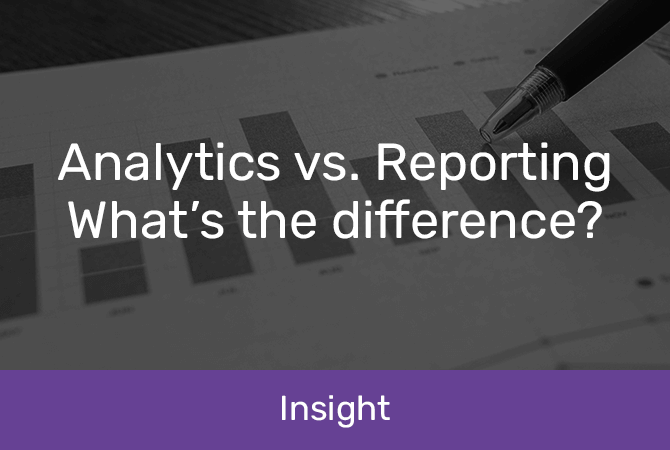
Analytics vs. Reporting: What's the difference?
Analytics can refer to a million things, ranging from a simple report to hardcore machine learning. To make better decisions, you need to be aligned on what people in the room mean when they say “analytics” – otherwise, your implementation plans will go astray.
Reporting ≠ Analytics
Google Analytics is one of the most commonly used applications in business today. As useful as it is, it’s not actually an analytical tool - it’s a reporting tool. Here’s the difference between reporting and analytics.
- Reporting is about taking existing information and presenting it in a way that is user friendly and digestible. This often involves pulling data from different places, like in Google Analytics, or presenting the data in a new way. Reporting is always defined and specified - it’s about getting reconciliation and making it accurate, because the business depends on the accuracy of those numbers to then make a decision.
- Analytics is about adding value or creating new data to help inform a decision, whether through an automated process or a manual analysis. Unlike reporting, analytics is about uncertainty - you use it when you don’t know exactly how to come to a good answer. This could be because it’s a complicated problem, or because it’s a challenge that isn’t well-defined, or because it’s a situation that changes frequently so the answer you got yesterday is unlikely to help you today.
![]()
Importantly, these differences mean that the kinds of people who will love building and producing reports are not the same people who will love doing analytics. We find that people who are good at reporting are most happy when things match up perfectly in the data, meaning when you put them in an uncertain situation that requires analytics, they’re not in their element. A data analyst, on the other hand, might get easily bored with reporting but loves the ambiguity of the situations that require solving new problems and coming up with creative solutions. The answer they produce might not be 100% perfect, but it’s useful – and they are okay with that!
Future-focused vs. rear-view mirror analytics
If you are building analytics capability and are unsure of your next steps (or you’re not taking steps quickly enough), then we suggest you divide your analytical tasks up between your in-house team and your analytics partner.
The most practical way to do this is to have your internal team focus on what’s happening right now and what has happened in the past, and for the analytics partner to focus on predicting what’s going to happen in the future. Here’s why.
- Rear-view mirror analytics: What’s happened in the past should be well-understood and measured within your business, meaning the job becomes actually digging down in to why it happened – something that can be easily arranged internally
- Future-focused analytics: In order to do a good job of predictive analytics, on the other hand, you need a lot more experience around handling assumptions and uncertainties, which third party analytics experts are bound to have a lot of
With that said, looking to the future shouldn’t be a fully outsourced analytics function – you need the internal domain knowledge to make it work well, and you'll want to be involved so that your team can learn and capture that future-looking IP into your own predictive capabilities.
Which do you need – reporting, or analytics?
When you’re talking about driving value from ‘analytics’, it’s important to have a clear idea of what you mean. Are you talking about getting better reporting and insight into what’s happening? Or getting better at collecting your data and making it available throughout the business? Or using your data to optimise and create business value?
![]() Given the confusion around the word ‘analytics’, we highly recommend making sure you and all other parties involved fully understand what is being meant by it before embarking on any initiatives. Clarifying this up front will help you get the right people in the room to have the right conversations and hopefully facilitate a good outcome.
Given the confusion around the word ‘analytics’, we highly recommend making sure you and all other parties involved fully understand what is being meant by it before embarking on any initiatives. Clarifying this up front will help you get the right people in the room to have the right conversations and hopefully facilitate a good outcome.
Unsure where to start? Get in touch with us to learn more about how we’ve helped dozens of businesses solve sticky challenges, unlock customer insight and cut costs by millions through data analytics.














































